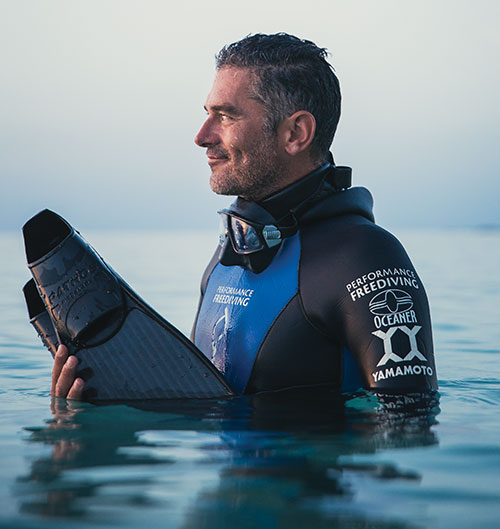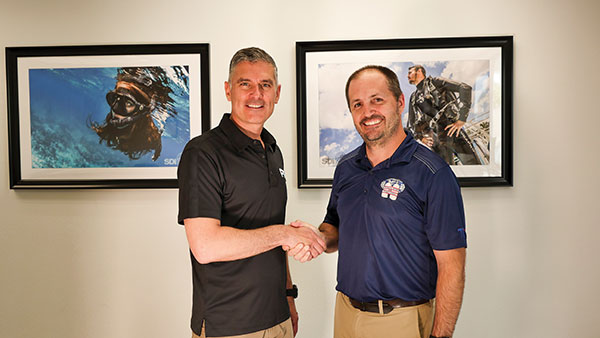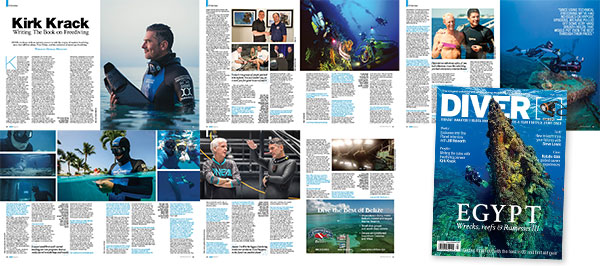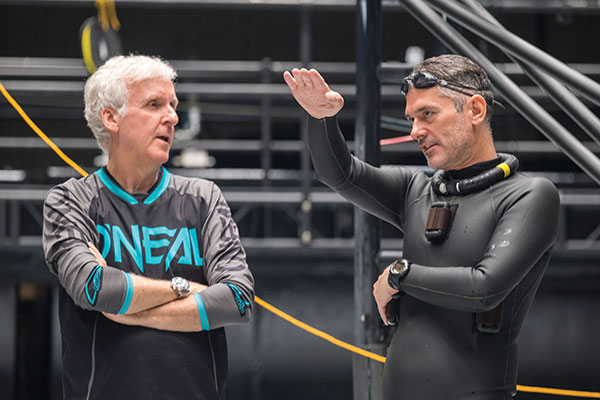Preview: Kirk Krack – writing the book on freediving

The following is an abridged version of an extensive ten page feature interview in the Fall 2019 issue of DIVER magazine, written by Michael Menduno.
Kirk Krack is one of the most prolific and innovative trailblazers in sport diving, yet ironically, most divers (DIVER readers excluded) have never heard of him—at least not in scuba world. However, among freedivers, he is held in near reverent esteem.
For good reason.
Over the last 20-plus years, the soft-spoken trainer and educator has developed and codified the foundations of modern freediving, including many fundamental techniques, knowledge, and safety protocols primarily through his company Performance Freediving International (PFI), the second oldest freediving training agency in the world. Today his breath-hold oeuvre serves as the underpinnings for many of the training programs on the market. In fact, it’s not an exaggeration to say that Krack is largely responsible for writing the book on freediving.
Not one to rest on his laurels, the former trimix instructor trainer is now actively engaged, almost single-handedly, in bringing mixed gas technology to the freediving community, which at first blush may seem like a contradiction in terms. Krack calls it “technical freediving.”
DIVER: First of all, congratulations on joining the TDI-SDI-ERDI family. I imagine this will have a big impact on getting your ideas out there.
Kirk Krack: Yes, absolutely. The TDI brand is the industry leader, not only in market share but in the development and quality of their programs, and their vision and the adherence to standards. It very much parallels PFI, not in terms of market share, but certainly from the quality of the programs and the adherence to standards. So, it’s a really good thing for us.
It removes the headaches of administration, and enables us to get out the programs and changes in programs that I’ve wanted to make but have been too busy. We now have a full marketing team, product development team, and a full customer service team that can take PFI, put it on steroids and take it to a market of over a million certified ITI members and 15,000 professional members. Most importantly, we’ll still get to have that say in the quality of the educational process and the future of the program.

DIVER: It will enable you to stay focused on the training and professional development?
Exactly. What we’ve done is to split PFI into two entities. The new PFI is the certification agency under the ITI umbrella that develops standards and product development and provides customer service. I’m a shareholder in that along with Brian Carney, president of ITI. Then there’s Performance Freediving Academy (PFA), which we’ll retain. PFA will run a full suite of training programs from recreational to professional and career development. We’ll also run training camps and competitions and serve our institutional and private clients.
DIVER: So, if I wanted to become a PFI freediving instructor I would train through PFA.
Right! PFA will be the group to develop the professional market. We’re going to go from a handful of instructors to buckets full depending on the pick-up rate from the TDI SDI group. Conservatively if 5% of ITI instructors want to become PFI instructors, we’re potentially talking about 750 new instructors. By comparison, today PFI has trained over 160 instructors; probably two-thirds are currently active, and we’ve certified in excess 10,000 freedivers.
DIVER: I can’t help thinking that joining up with TDI is also going to give a huge boost to “technical freediving.” I mean, most tekkies would likely consider it perfectly reasonable to breath-up on nitrox to extend their breath-hold dive.
Absolutely. You’ll have technical divers who will get into freediving just for the fun and experience of the tech freediving aspect of it. Of course, they’re still going to have to learn to become a fully competent freediver without the technical side and then move into the technical side of it.

DIVER: I’m guessing that most people don’t realize that you were an extremely active trimix instructor back in the early to mid-1990s. You started teaching nitrox in 1992 at your shop in the middle of the Canadian prairies before moving to the Cayman Islands and co-founding Divetech, just as tech diving was taking off.
[Krack smiles] On Cayman we had the equivalent of eight technical setups; doubles, stage bottles, equipment, everything you needed to do up to trimix. We also had this massive blending system. Most of my customers were the instructors on the island.
I wasn’t just a weekend warrior. One day I would literally have four advanced nitrox people. The next day I’d have three technical nitrox people. The day after that I’d have a trimix class. And this went on from Monday to Sunday. There were weeks when I was jumping between teaching technical nitrox and trimix every day, and I would go back to my condo with a 90 ft³ cylinder of 100% oxygen (O2) and I’d read a book for the next four hours breathing O2 to zero out my tissues before the next day of teaching.
DIVER: Your shop on Grand Cayman became the world headquarters for IAFD. You trained Tanya Streeter for her No-limits world record in 1998, and then Brett LeMaster for the Constant Ballast world record in 1999, and you started writing freediving manuals!
That’s right. I was one of the first to write a freediving specific manual. There was a short pamphlet by Jan Neil [Mastering
Breath-hold Diving published by NAUI in 1997] that covered some of the physics and physiology but it was very rudimentary. Their reference to shallow water blackout was very cursory and the book didn’t address technique. There was also an important hard cover book by Dave Sipperly and Terry Maas titled Bluewater Hunting and Freediving that came out in 1998 but it really more about spearfishing than anything else. Both books were informational; they did not present a “how to” system,
I wrote the manuals, standards and procedures for IAFD and also shot videos. But they were pretty raw, and didn’t have a ton of technique. We did start to figure out hook and recovery breathing working with Tanya and Brett based on what felt good to get through their records, but they were still being developed. It wasn’t until Brett and I started teaching our own programs under the PFI banner that we really started to make leaps and bounds forward.
DIVER: So everyone is on the same page!
Exactly. The whole idea our system of training, is that an instructor in, say, Australia is going to teach someone there and then they’ll be able to come dive with me here in Canada and speak the same freediving language and protocols. “Ok, we’re going to do one up, one down. You’ll wait 30 seconds, while the recovering diver does their hook breaths.” And so on.
DIVER: PFI just introduced its “technical freediving” course aimed at professionals like safety divers and instructors. The idea of course, just like in scuba, is to breath a nitrox mix and or pure oxygen, before, during or after the freedive in order to improve a diver’s safety and performance, enabling them to go deeper and or stay down longer and reduce the risk of hypoxia. What’s the response been?
The response so far has generally been one of excitement and interest. There has been some push back from some lead members in other organizations, as was expected, but in time and with some experience they’ll also eventually see the benefits for working freedivers where the ‘best tool for the job’ may step outside the purist’s idea of what freediving is. It can definitely enhance safety.
DIVER: You have been using oxygen as a recovery gas for training and world record attempts since 2001, and also incorporated nitrox and oxygen use for safety divers for PFI’s annual “Deja Blue” competition. Do you think others will follow PFI’s lead?
Over the next five years I think there will be the obvious areas where it will be fully integrated, like for safety divers and as a recovery gas for competitive freedive training and competitions. The use by safety freedivers is a no-brainer. It gives them an extra reserve to wait for an athlete that’s running behind and also the breath-hold to swim a diver to the surface if needed.

DIVER: I am assuming that you also used it for Mission Impossible Rogue Nation with Tom Cruise doing that four-minute breath-hold.
That was really the first Hollywood movie where I brought tech freediving into play, and for all the same reasons: short surface intervals, lengthened breath-holds, and to combat fatigue. Interestingly, we used 50% [50% oxygen, 50% nitrogen] but it was a fight to get it. I was up against a very determined anti-nitrox/O2 for breath-hold dive sentiment, simply because of the fear of the unknown and lack of understanding. Ultimately, we won out.
Tom Cruise would routinely do four minutes. I mean by the time we would get down on the scene, get set up, cameras rolling, shoot the scene and finish, it was three to four minutes breath-holds day in day out. The guy’s an absolute athlete and an amazing student to work with. He actually did a 6.5-minute dry breath-hold on air.
DIVER: Has technical Freediving been used for your work training actors on Avatar 2?
We’ve done well over a couple hundred thousand freedives shooting Avatar these past two and a half years with a whole host of different ages, body types, fitness, and experience levels. Since using technical freediving we’ve had no issues or hypoxic episodes. We have pulled off some very hard breath-holds that would put even the best through their paces. So any apprehension about nitrox breath-holds in the movie business should be fully dispelled and its use widely accepted after Avatar.
For the full interview with Kirk, read the glorious print edition of DIVER, or the online digital edition.







